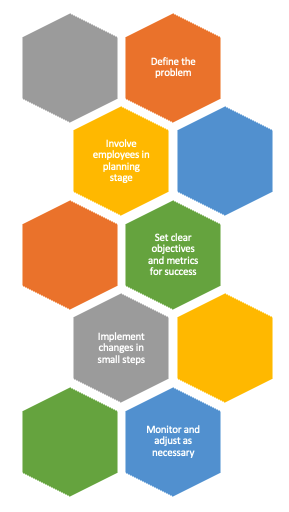 Strengthening your supply chain one link at a time.
Strengthening your supply chain one link at a time.
In 1939, the Plan-Do-Check-Act (PDCA) cycle was first developed by American physicist Walter A. Shewhart. Later, in the 1950s, management consultant Dr. William Edwards Deming developed the method of identifying why some processes fail to meet desired expectations. Deming’s approach has since become a popular strategy tool, used by many different types of organizations. Continuous improvement is a proactive approach to improve customer satisfaction by prioritizing the elimination of waste. A PDCA cycle is has four stages in achieving continuous improvement.

The first stage in the PDCA process is to plan. The primary objective is to identify any problems or gaps to find opportunities for improvement. It’s important to clearly define the problems and opportunities, set goals and objectives, and develop a plan of action. Utilize flowcharts, affinity diagrams, and cause and effect diagrams to help drive desired results. Next, the “Do” stage is where you map out new processes and test the proposed solutions. To minimize risk, small scale deployments will allow you to learn quickly and adjust as needed with less up-front cost. Be sure to measure the performance and collect the data necessary to make an evaluation. This may include changes to production processes, maintenance strategies, implementing training or changing work practices. Then, during the “Check” stage, review and analyze the results to identify lessons learned. Data such as production output, machine capacity and safety statistics should be measured against the forecasted benefits realization detailed in the plan. Lastly, the “Act” stage is where you take action based on what you learned. If the change is unsuccessful, repeat the cycle again with a different strategy. On the other hand, if you were successful, implement what you have learned from the test pilot into other areas and/or business lines. Standardize the process and implement throughout the facility.

PDCA is an important tool for continuous improvement as it encourages data-driven decision making, supports effective problem solving, and promotes teamwork and collaboration. The greatest challenge of implementing the PDCA cycle is resistance to change. It’s common for staff to be skeptical of new processes and procedures, especially if they’ve performed tasks the same way for many years. This can lead to delays and lack of engagement. For this reason, include employees at the very beginning to not only to identify process gaps but also recommend solutions. Employees will feel a sense of ownership and be more likely to accept the changes. Best practices to consider when implementing the PDCA cycle are shown in the image below:

PDCA creates a culture of problem solvers and critical thinkers. When PDCA is applied within a maintenance program, it can fast-track constant improvement and help the company optimize their processes and operations. If every step is executed consistently and correctly, benefits are realized faster. Keep in mind, PDCA is not a one-time occurrence. It is an ongoing, continuous process and, therefore requires commitment and buy-in from senior leadership. Without senior leadership buy-in, the PDCA cycle will become unsustainable in the long term. Empowering individuals to make decisions and improve inefficiencies is a critical aspect of improving organizational culture. Creating a culture of continuous improvement within your organization requires dedication but the results are worth it. Define clear goals and stay committed!
—Ashley Rhodes, St. Onge Company